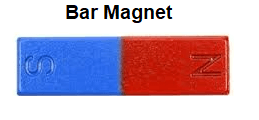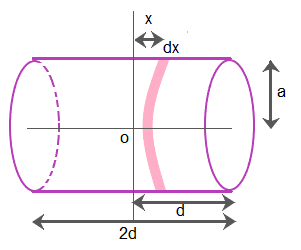Bar Magnet and SolenoidThe function of a bar magnet and solenoid is to generate the magnetic field. Both the devices have different structures and properties but work the same. Let's discuss this in detail. Bar MagnetA bar magnet is a rectangular piece of metal with permanent magnetic ability. It has two poles, Northand South. It does not require any current to produce the field. It produces its magnetic field. Examples of bar magnets include refrigerator magnets and compass needles. The bar magnet automatically aligns itself along the magnetic field when suspended freely. The applications of bar magnets include laboratories, radios, televisions, and medical. The same poles repel each other, while the opposite poles of two magnets attract. The laws are named as the law of attraction and repulsion. Law of attraction The magnet's North Pole will attract towards the South Pole of the other magnet. Similarly, the magnet's South Pole will attract towards the North Pole of the other magnet. Law of Repulsion The North Pole of a magnet will repel the North Pole of the other magnet. Similarly, the South Pole of a magnet will repel the South Pole of the other magnet. A simple bar magnet is shown below: 
Classification of Bar MagnetsThere are two types of bar magnets, natural magnets,and artificial magnets. Neutral magnets are found in nature without any artificial efforts. It has a low magnetic field. The artificial magnets are man-made with different shapes. It has strong magnetic fields. For example, ring magnets, horse magnets, bar magnets, etc. The magnetic strength of the bar magnet is highest at the poles. Types of bar magnetThere are major two types of bar magnet, which are listed as follows:
Cylindrical Magnets The cylindrical magnets are in the shape of cylinder. It is also known as rod magnets. It has high magnetism properties due to its large thickness. It is used in experiment-related applications. Rectangular magnet The rectangular magnet is in the shape of a rectangle. It also has high magnetic strength. A bar magnet is also a type of rectangular magnet. It is used in applications, such as electronic devicesand medical purposes. Advantages of bar magnetsThe advantages of bar magnets are as follows:
SolenoidThe solenoid is an electromechanical device that converts electrical energy to mechanical energy. Solenoids are also known as electromagnets because it generates the magnetic field from the electric current flowing in the circuit. The magnetic property of the solenoid is not permanent. It stays as long as the current flows through the circuit. The solenoid circuit comprises a coil (wire arranged in the form of a helix), metal core, and the external power supply. The current flows through the coil when the power supply is switched ON. The coil is wounded around the metal core in the form of a helix. It creates a magnetic field, and the metal core behaves like a magnet. We can test it by bringing a metal iron near the electromagnet. There are various applications of solenoid, such as inductors, antennas, medical machines, engines, etc. Advantages of the solenoidThe advantages of the solenoid are as follows:
For detailed information about the solenoids, click on solenoid (https://www.javatpoint.com/solenoid). Bar magnet vs. solenoidThe function of bar magnet and solenoid is to produce magnetic field, but the process of magnetic field generation and their properties are different. The differences between bar magnet and solenoid are listed in the below table:
Bar magnet as an equivalent SolenoidThe bar magnet as an equivalent solenoid can be proved using a finite length solenoid, as shown below: 
Where, R is the radius of the solenoid 2d is the total length of the solenoid N = number of turns on a solenoid I = current flowing through the solenoid dx = thickness of a small element x = distance from the center O to the small element The magnetic field due to N turns of a solenoid is given by: dB = μNdxIa2/ 2[(r - x)2 + a2]3/2 Considering the axial field of the solenoid r > > 1 and r > > a, the denominator part can be expressed as: [(r - x)2 + a2]3/2 = r3 Integrating from -1 to 1, B = μ NI2a2/ 2r3… (1) The magnetic moment of a solenoid is given by: m = N x I × A Where, I is the amount of current flowing through the coil A is the cross-sectional area N is the number of turns on a solenoid Substituting the value of magnetic moment in equation (1), we get: B = μ 2m/ 2r3 Or B = μo 2m/4𝛑 2r3 The magnetic moment of a bar magnet is given by: m = P × 2d Where, P is the pole strength d is the distance between the two poles (North and South) of a magnet or the total length of the magnet The magnetic moment of the solenoid is equal to the mar magnet. Thus, we can say that the bar magnet behaves an equivalent solenoid. ExamplesLet's discuss some examples based on the bar magnet and solenoid, which will be in the form of MCQ's (Multiple Choice Questions). Example 1: Solenoids are often known as:
Answer: (b) Electromagnets Explanation: The magnetic property of solenoids depends on the electric current flowing in the circuit. If there is no current, no magnetic field is induced. Hence, solenoids are also known as electromagnets. Example 2: Electromagnets are used in applications:
Answer: (d) All of the above Explanation: Electromagnets or solenoids are used in various applications, such as speakers, buzzers, motors, generators, and electric bells. Example 3: What is the magnetic moment of a bar magnet when the distance of a pole from center is 3m and the pole strength of 10 Ampere meter?
Answer: (c) 60 Am2 Explanation: The magnetic moment of a bar magnet is given by: P × 2d Where, P is the pole strength d is the distance between the two poles Magnetic moment = 10 x 2 x 3 = 60 Am2 The distance given is from the center to a pole. Thus, we have consider it as 'd.' If the distance is between the two poles, it will be considered as '2d.' Example 4: Unit of the magnetic moment of a magnet is:
Answer: (b) Am2< Explanation: The unit of the magnetic moment of a magnet is Ampere -square meter.
Next TopicEffects of Acid Rain on Taj Mahal
|
 For Videos Join Our Youtube Channel: Join Now
For Videos Join Our Youtube Channel: Join Now
Feedback
- Send your Feedback to [email protected]
Help Others, Please Share










